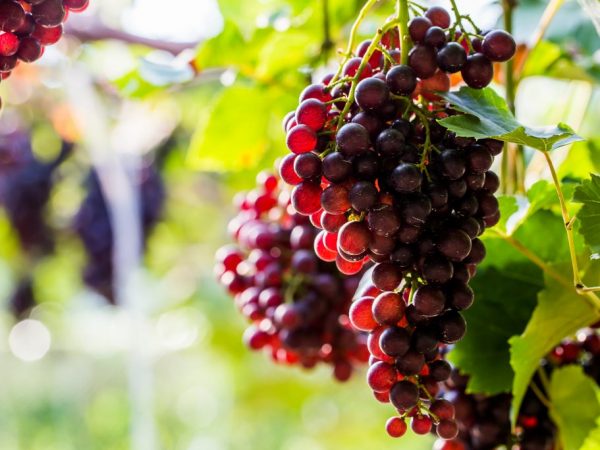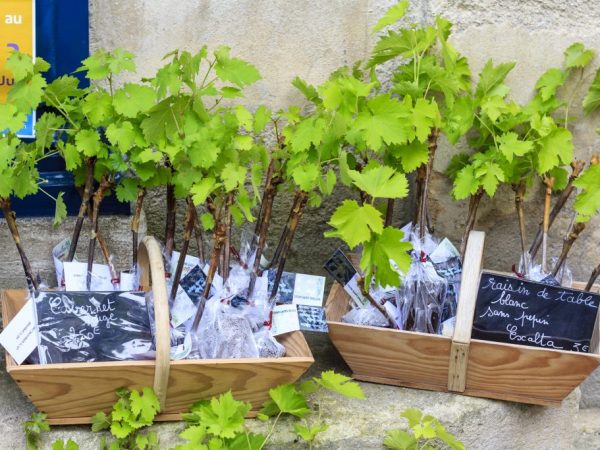Growing grapes Levokumsky
As a child, people prefer to consume sweet drinks that are made from natural grape crops. With increasing age, preferences change for delicious wine or sweet cognac. All these drinks are made from special grape varieties, one of which is the Levokumsky grape.

Growing grapes Levokumsky
Characteristics of the variety
Fruit grapes of the Levokumsky variety are industrial crops. Its main difference from other fruit crops is the excessive juiciness of berries, which allows you to prepare delicious drinks. The description indicates that this fruit crop is considered to be medium-early and has a growing season of only 120 days.
Description of the bush
Bushes are high, up to 5 m. Leaves are large. The average length of a green leaf plate is 12 cm. The width is only 5 cm. 5 blades are formed on each leaf, which give it an unusual appearance. The vine is powerful, well-formed. Shoots are located frequently. The flowers are bisexual, which has a positive effect on the amount of harvested products. Refers to self-pollinated crops, therefore does not need other pollinators.
Features of the fetus
According to the description, the Levokumsky grape variety has large pink berries, weighing about 16 g.
Bunches of cylindrical shape and. A different number of berries are formed on each of them. Average weight - 800 g. The pulp is juicy, dense. Inside there are small seeds, in small quantities.
The taste is dominated by sweetness. Delicious wine is obtained from products of this type.
Important rules for growing
It is better to plant in loamy or chernozem soils, where the highest yield is noted. If there is only the possibility of planting in dense and heavy soils, then sand is introduced into them in advance in order to slightly reduce this density. The acid-base balance of the earth should not exceed 3%. Otherwise, lime 3 kg / m² is added to the ground. Planting is best done in sunny areas in order to harvest a high-quality crop in August.
Sapling selection rules
When choosing a seedling, consider the following parameters:
- sedimentary material must be grafted, so it is better to buy it from nurseries, not markets;
- there should be no signs of past diseases on the surface of the seedling - this reduces the immune system of the plant, and it will die when struck by the first infections;
- the height of the planting material should be 1.5 m, the length of the roots 30-40 cm;
- the age of the seedling is no more than 2 years, such specimens are more resistant to parasites and diseases.
Landing rules

Planting grapes is best in spring.
Planting is carried out in the spring. For this, in the fall, they begin to prepare a hole (70x70 cm). If the groundwater approaches the surface of the earth closer than 2 m, a drainage system must be installed. It is easy to build it from crushed rubble or tree branches. 2/3 of the wells are filled with a mixture of humus, earth and compost, mixed in a 1: 1: 3 ratio.
A small depression is made inside the poured mixture into which the roots of the seedling are placed. If the depth is not enough, then it is allowed to cut the roots to 20 cm. The rest of the hole is covered with fertile soil and watered with 10 liters of water. If you live in a windy region, then it is better to tie the seedling to a metal support that will protect it from deformation. The distance between the bushes should be 3 m, and between the rows 4 m.
Care activities
Levokum grapes need high-quality care:
- Watering is carried out at intervals of 15 days. This is enough to moisten the soil, but not lead to root rot. The optimal amount of water for each bush is 20 liters. The water should be warm to improve adhesion between roots and soil.
- After watering, after 5 days, be sure to loosen the top layer of the earth. The depth of penetration of the hoe is no more than 8 cm. This allows to improve the penetration of air and useful elements into the roots, but not to disturb their structure. Weeds are removed on which parasites multiply.
- Feeding is carried out in several stages. Feed the crop for the first time 2 years after planting. This is done to give the plant time to acclimate to the external environment. In the spring, intra-root dressing is carried out using potassium nitrate (20 g per 5 l of water). In the summer, top dressing is carried out with a superphosphate solution (40 g per 10 l of water). In autumn, the root part is mulched with a mixture of 1 kg of humus and 3 kg of straw, per 1 bush.
- During spring pruning, all extra eyes on the shoots are removed. Each of them should have no more than 5 eyes. In the summer, dry and damaged parts of the vine are removed.
Diseases and pests
Resistant Levokumsky grapes do not lend themselves to powdery mildew and root rot. Under conditions of cultivation in the Moscow region, the plant is often affected by olive spot and coccomycosis. Manganese solution (30 g per 5 liters of water) helps to fight olive spot. Copper sulfate helps with coccomycosis (20 g per 5 liters of water).
The description indicates that the Levokumsky grape variety is resistant to mite infestation. The vine is affected only by aphids and rarely by a flea. An effective remedy against aphids is considered to be preparations that contain copper in their composition. The best option would be Oxyhom, since the strongest. You need to dilute 30 g of the drug in 10 liters of water. A solution of colloidal salt (10 g per 5 liters of water) helps with flea beetles. The processing interval is 10 days.
Conclusion
This fruit grape variety is used in all spheres of human life. It makes not only delicious desserts, but also sweet alcoholic drinks. This variety is not difficult to care for, which is why it is often grown by beginners in the gardening industry.

